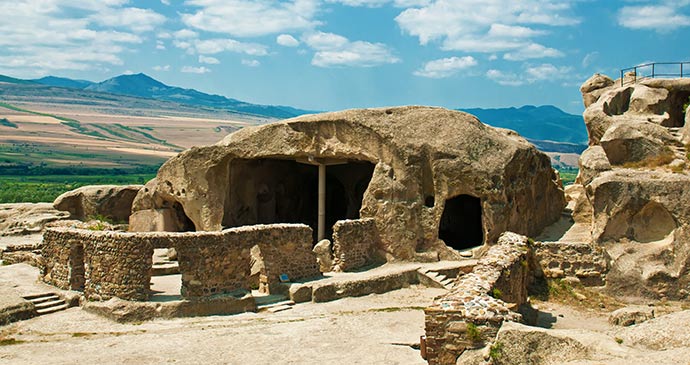This evocative cave city is close to Stalin’s home town, Gori.
About 10km east of Gori along the Mtkvari Valley, visible from trains along the main line, is the cave-city of Uplistsikhe. The Silk Road ran along the hills to the north (hence the positions of Gori, Kaspi and Mtskheta, all on the north side of the Mtkvari), and excavations in the area have shown evidence of settlement from the second half of the 4th millennium BC onwards.
Uplistsikhe was a religious centre by 1000BC (its temples dedicated mainly to the sun goddess) and a trading centre by at least the 5th century BC. Later it became more isolated and was inhabited by monks until it was destroyed in the 13th century by Chinghiz’s son Khulagu. Most of the caves have been at least partly eroded away, so that it takes a considerable feat of the imagination to really understand what the city was like.
Over the centuries the site has suffered greatly from the elements, although channels were built to carry off storm water and prevent flash floods (drinking water was brought 5–6km from a spring just 44m above, through a beautifully engineered system of ceramic pipes and a tunnel). In addition, cracks are developing in many of the caves, which may crumble away in the next ten to 30 years unless action is taken.

The tour of the ruins is only for the able. Start by scrambling up rocks past grain pits to the remains of a theatre built in the 2nd or 3rd century AD, complete with orchestra pit; the auditorium side has now all collapsed into the river and been washed away, and the stage roof is held up by concrete pillars. There’s even a bread oven in the middle of the stage.
The largest hall in the city is known as Tamar’s Hall, although Queen Tamar never lived here; its front wall has gone, but it’s otherwise intact. The marani (wine-storage room) next to it, one of three in the city, dates from after her time.
There’s an underground prison, 8.5m deep, just below Tamar’s Hall, and to the south is what must have been a pharmacy, with eight layers of storage spaces (about 15cm cubes), where traces of herbs and wrapping parchments have been found. To the north of Tamar’s Hall is another hall, now roofless, which was once a church – there’s very little left except for the stumps of four columns, and a basin for the blood of sacrificed animals.
Further up there’s a very obvious conventional church, a three-nave basilica built of red brick in the 9th–10th centuries, which survived the Mongol onslaught, although all 5,000 resident monks were killed. The church’s frescoes were all whitewashed in the 19th century.
On the way back down you’ll pass the market, with its stone stalls, and may finish by going down through a 41m tunnel (designed to be used by water carriers) to exit on the track beside the river. This leads to a village immediately to the west, whose inhabitants were removed in 1968 (though at least one house is clearly in use again).
You might be tempted to set out to walk back to Gori along the north bank of the river, but you should be aware of the deep gullies blocking the way.